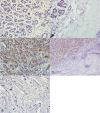N-Acetylgalactosaminyltransferase-14 as a potential biomarker for breast cancer by immunohistochemistry
- PMID: 20356418
- PMCID: PMC2873381
- DOI: 10.1186/1471-2407-10-123
N-Acetylgalactosaminyltransferase-14 as a potential biomarker for breast cancer by immunohistochemistry
Abstract
Background: The post-translational modification of proteins, including glycosylation, differs between normal and tumor cells. The UDP-N-acetyl-D-galactosamine polypeptide N-acetylgalactosaminyltransferases (GalNAc-Tases) family of enzymes regulates the initial steps of mucin O-glycosylation and is responsible for the altered glycosylation state observed in cancer cells. Recently it was found that GalNAc-T14 mRNA is heterogeneously expressed in breast carcinomas compared to normal tissue, however the expression profile of GalNAc-T14 protein in breast carcinomas compared to normal tissue is still unknown. In this study, we assessed the expression profile of GalNAc-T14 protein in malignant and non-malignant breast tissues by immunohistochemistry to evaluate whether GalNAc-T14 might be a potential biomarker for breast cancer.
Methods: In formalin-fixed tissues, the expression level of GalNAc-T14 protein was evaluated by immunohistochemistry assay in breast tissues. Expression profiles were assessed in normal tissues, benign fibroadenomas and several types of carcinomas.
Results: Our results showed that GalNAc-T14 was heterogeneously expressed in breast carcinomas compared to non-malignant tissue. GalNAc-T14 expression was observed in 47/56 (83.9%) carcinoma samples, 7/48 (14.6%) non-malignant breast tissue samples. GalNAc-T14 expression level was associated with histological grade. For this enzyme a significant association with invasive ductal type, mucinous adenocarcinoma and ductal carcinoma in situ (DCIS) type was found.
Conclusion: Our results provide evidence that GalNAc-T14 may be a potential biomarker for breast cancer by immunohistochemistry. GalNAc-T14 expression level was associated with histological grade. GalNAc-T14 expression can provide new insights about breast cancer glycobiology.
Figures



Similar articles
-
UDP-N-acetyl-D-galactosamine: polypeptide N-acetylgalactosaminyltransferase-6 as a new immunohistochemical breast cancer marker.J Histochem Cytochem. 2006 Mar;54(3):317-28. doi: 10.1369/jhc.5A6783.2005. Epub 2005 Oct 31. J Histochem Cytochem. 2006. PMID: 16260590
-
N-Acetylglucosaminyltransferase III (GnT-III) but not N-Acetylgalactosaminyltransferase-6 and 8 are Differentially Expressed in Invasive and In Situ Ductal Carcinoma of the Breast.Pathol Oncol Res. 2019 Apr;25(2):759-768. doi: 10.1007/s12253-019-00593-5. Epub 2019 Jan 28. Pathol Oncol Res. 2019. PMID: 30689164
-
Cloning and characterization of a novel UDP-GalNAc:polypeptide N-acetylgalactosaminyltransferase, pp-GalNAc-T14.Biochem Biophys Res Commun. 2003 Jan 17;300(3):738-44. doi: 10.1016/s0006-291x(02)02908-x. Biochem Biophys Res Commun. 2003. PMID: 12507512
-
Expression of UDP-N-acetyl-alpha-D-galactosamine-polypeptide galNAc N-acetylgalactosaminyl transferase-3 in relation to differentiation and prognosis in patients with colorectal carcinoma.Cancer. 2002 Apr 1;94(7):1939-46. doi: 10.1002/cncr.10423. Cancer. 2002. PMID: 11932895
-
UDP-N-acetyl-D-galactosamine:polypeptide N-acetylgalactosaminyltransferase- 6 (pp-GalNAc-T6): Role in Cancer and Prospects as a Drug Target.Curr Cancer Drug Targets. 2017;17(1):53-61. doi: 10.2174/1568009616666160922102641. Curr Cancer Drug Targets. 2017. PMID: 27659430 Review.
Cited by
-
Polypeptide N-Acetylgalactosaminyltransferase 14 (GALNT14) as a Chemosensitivity-Related Biomarker for Osteosarcoma.J Oncol. 2023 Feb 2;2023:1083423. doi: 10.1155/2023/1083423. eCollection 2023. J Oncol. 2023. PMID: 38024474 Free PMC article.
-
Lectin nanoparticle assays for detecting breast cancer-associated glycovariants of cancer antigen 15-3 (CA15-3) in human plasma.PLoS One. 2019 Jul 25;14(7):e0219480. doi: 10.1371/journal.pone.0219480. eCollection 2019. PLoS One. 2019. PMID: 31344060 Free PMC article.
-
C1GALT1 overexpression promotes the invasive behavior of colon cancer cells through modifying O-glycosylation of FGFR2.Oncotarget. 2014 Apr 30;5(8):2096-106. doi: 10.18632/oncotarget.1815. Oncotarget. 2014. PMID: 24758762 Free PMC article.
-
Identification of GALNT14 as a novel neuroblastoma predisposition gene.Oncotarget. 2015 Sep 22;6(28):26335-46. doi: 10.18632/oncotarget.4501. Oncotarget. 2015. PMID: 26309160 Free PMC article.
-
Unconventional protein post-translational modifications: the helmsmen in breast cancer.Cell Biosci. 2022 Feb 25;12(1):22. doi: 10.1186/s13578-022-00756-z. Cell Biosci. 2022. PMID: 35216622 Free PMC article. Review.
References
-
- White KE, Lorenz B, Evans WE, Meitinger T, Strom TM, Econs MJ. Molecular cloning of a novel human UDP-GalNAc:polypeptide N-acetylgalactosaminyltransferase, GalNAc-T8, and analysis as a candidate autosomal dominant hypophosphatemic rickets (ADHR) gene. Gene. 2000;246:347–356. doi: 10.1016/S0378-1119(00)00050-0. - DOI - PubMed
-
- Zhang Y, Iwasaki H, Wang H, Kudo T, Kalka TB, Hennet T. Cloning and characterization of a new human UDP-N-acetyl-alpha-D-galactosamine:polypeptide N-acetylgalactosaminyltransferase, designated pp-GalNAc-T13, that is specifically expressed in neurons and synthesizes GalNAc alpha-serine/threonine antigen. J Biol Chem. 2003;278:573–584. doi: 10.1074/jbc.M203094200. - DOI - PubMed
Publication types
MeSH terms
Substances
LinkOut - more resources
Full Text Sources
Medical
Molecular Biology Databases
Research Materials

